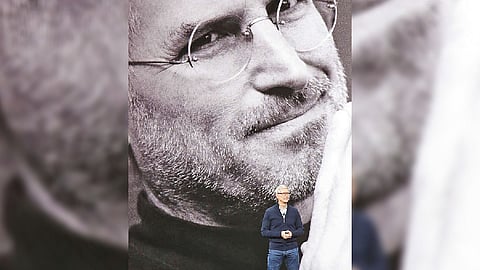

By: CLAY SHIRKY
Between 2001 and 2010, Apple launched the iPod, the iPhone, the MacBook Air and the iPad; each redefined its product category. Of these, the iPhone was the most important. Its obvious superiority forced every other company selling expensive phones to copy Apple’s design or collapse. The Apple of 2010 had a record of hardware innovation no other electronics firm could match. Including the Apple of 2020.
Steve Jobs died in 2011, leaving the firm in the hands of Jony Ive, the British-born designer-savant, and Tim Cook, a child of Alabama who’d become a master of supply chains and production costs. “After Steve,” by the Wall Street Journal reporter Tripp Mickle, traces the evolution and end of Ive and Cook’s partnership, involving compendious review of public sources and over 200 interviews with current and former Apple employees and advisers; the cast of characters itself runs to four pages.
Some of this technique is in response to Apple’s “culture of omertà” — apparently, neither Ive nor Cook agreed to speak to the author for attribution — but Mickle uses comparative descriptions to sketch out their differences, like how Ive drives to work in a bright yellow Saab, Cook in a drab Honda Accord.
Both men helped save a sinking Apple in the 1990s — Ive first, overseeing the design of a new line of computers with candy-coloured transparent cases. When the iMac launched in 1998, Jobs unveiled Ive’s creation by pulling a sheet off it, as if it were a sculpture, saying, “It looks like it’s from another planet, a good planet with better designers.” Those eye-catching iMacs improved the company’s public perception, staff morale and bottom line all at once. Apple was saved. Now it just had to grow.
That same year, Jobs tapped Cook to rework Apple’s inefficient production line. Cook, who’d previously run the supply chain for Compaq, was famously demanding and detail-oriented. Joe O’Sullivan, who was running operations when Cook arrived, said, “I saw grown men cry. … He went into a level of detail that was phenomenal.” Ive was also demanding, of both his colleagues and external suppliers. In one meeting, shown a piece of polished aluminium for a laptop case, Ive became visibly upset at imperfections barely visible to the others. Seeking to calm him, one of his colleagues handed him a red Sharpie, telling Ive to circle what was wrong. “I’ve got a different idea,” came Ive’s reply. “Get me a bucket of red paint. I’ll dip this in it and wipe off the things that are right.”
Perfectionism isn’t enough to create a great product, however. After Jobs’s death, there was uncertainty about what the Next Big Thing might be. Home automation, health care devices, self-driving cars, televisions and various headphones were all explored, and some launched. But for most of Ive’s remaining tenure, the centrepiece of Apple’s device work — and therefore of Mickle’s book — would be the Apple Watch.
Yet as the story unfolds, it becomes clear the watch will not be the Next Big Thing. As Ive acquires more control than he had over the iPhone, the watch shifts from a useful screen on your wrist into a fashion object. Meetings with the Vogue editor Anna Wintour, a product event in Paris and the creation of a $17,000 model run alongside gradually reduced expectations for its health tracking and battery life. By the time it finally launches and sales fall short of projections, the reader has seen it coming, one decision at a time.
In contrast, Cook faced a welter of events. He was called before Congress over taxes. He had to apologise for poor performance in the earliest iteration of Apple Maps.
In the epilogue, Mickle drops his reporter’s detachment to apportion responsibility for the firm’s failure to launch another transformative product. Cook is blamed for being aloof and unknowable, a bad partner for Ive, “an artist who wanted to bring empathy to every product.” Ive is also dinged for taking on “responsibility for software design and the management burdens that he soon came to disdain.” By the end, the sense that the two missed a chance to create a worthy successor to the iPhone is palpable.
Visit news.dtnext.in to explore our interactive epaper!
Download the DT Next app for more exciting features!
Click here for iOS
Click here for Android